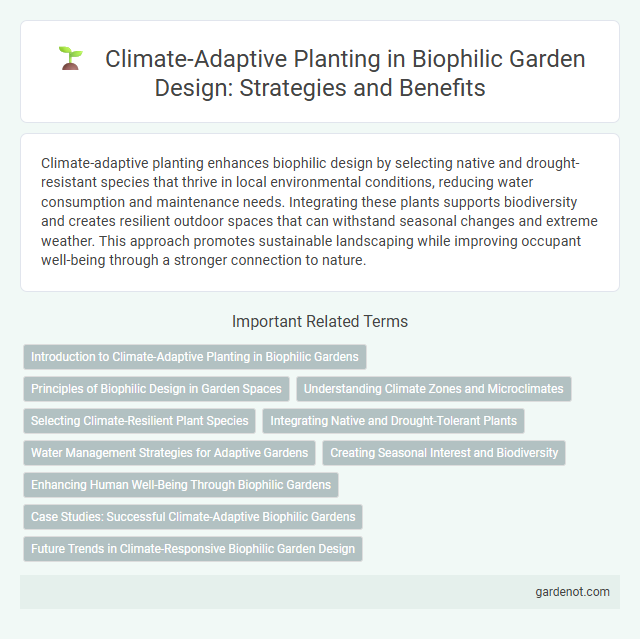Climate-adaptive planting enhances biophilic design by selecting native and drought-resistant species that thrive in local environmental conditions, reducing water consumption and maintenance needs. Integrating these plants supports biodiversity and creates resilient outdoor spaces that can withstand seasonal changes and extreme weather. This approach promotes sustainable landscaping while improving occupant well-being through a stronger connection to nature.
Introduction to Climate-Adaptive Planting in Biophilic Gardens
Climate-adaptive planting in biophilic gardens employs native and drought-resistant species to enhance resilience against climate variability while promoting biodiversity. This approach optimizes water use efficiency and soil health, reducing maintenance and environmental impact. Integrating climate-adaptive plants supports ecosystem services and strengthens urban green infrastructure under changing climate conditions.
Principles of Biophilic Design in Garden Spaces
Climate-adaptive planting in garden spaces embraces biophilic design principles by selecting native and climate-resilient species that enhance ecological connectivity and promote biodiversity. Incorporating year-round plant diversity and natural water management techniques supports environmental health while fostering human well-being through sensory engagement with nature. This approach aligns with biophilic design goals by creating dynamic, sustainable gardens that respond to local climate conditions and encourage restorative natural experiences.
Understanding Climate Zones and Microclimates
Climate-adaptive planting in biophilic design requires a precise understanding of climate zones and microclimates to ensure plant selection harmonizes with local environmental conditions. Identifying temperature ranges, precipitation patterns, and wind exposure within specific microclimates supports resilient vegetation that enhances biodiversity and reduces maintenance needs. Integrating native species adapted to these localized climate factors promotes sustainable landscapes that contribute to human well-being and ecological balance.
Selecting Climate-Resilient Plant Species
Selecting climate-resilient plant species is essential for effective climate-adaptive planting in biophilic design, ensuring vegetation thrives despite changing weather patterns. Drought-tolerant native plants and heat-resistant varieties reduce maintenance needs and water consumption while enhancing ecosystem stability. Integrating species adapted to local microclimates supports biodiversity and promotes long-term landscape sustainability.
Integrating Native and Drought-Tolerant Plants
Climate-adaptive planting in biophilic design emphasizes the use of native and drought-tolerant plants to enhance ecosystem resilience and reduce water consumption. Integrating species such as California poppy, sagebrush, and agave ensures sustainable landscaping that supports local biodiversity and requires minimal irrigation. These plants improve soil health, provide habitat for pollinators, and contribute to energy-efficient microclimates within urban environments.
Water Management Strategies for Adaptive Gardens
Climate-adaptive planting in biophilic design prioritizes water management strategies that optimize natural irrigation and reduce water consumption through drought-resistant species and efficient rainwater harvesting systems. Implementing permeable soils and mulching techniques enhances moisture retention, while strategically placed vegetation minimizes runoff and soil erosion. These adaptive gardens leverage native plants and smart irrigation to create resilient landscapes that thrive under variable climate conditions.
Creating Seasonal Interest and Biodiversity
Climate-adaptive planting enhances biophilic design by selecting plant species that thrive in local climatic conditions, ensuring resilience and sustainability. Incorporating a diverse mix of native plants creates seasonal interest through varied bloom times, foliage changes, and textures that attract pollinators and wildlife. This approach promotes biodiversity, improving ecosystem health and supporting local fauna within urban and residential landscapes.
Enhancing Human Well-Being Through Biophilic Gardens
Climate-adaptive planting in biophilic gardens utilizes native and drought-resistant species to create sustainable green spaces that thrive under local environmental conditions. These gardens improve human well-being by reducing urban heat, enhancing air quality, and providing restorative natural settings for stress reduction and mental health benefits. Integrating climate-resilient vegetation supports biodiversity while promoting ecosystem services critical for healthy urban living environments.
Case Studies: Successful Climate-Adaptive Biophilic Gardens
Case studies of climate-adaptive biophilic gardens demonstrate the effective integration of native and drought-resistant plant species to enhance ecosystem resilience and reduce water consumption. Gardens like the Singapore Botanic Gardens and California's Ruth Bancroft Garden showcase how strategic plant selection and microclimate management foster biodiversity and sustainable urban green spaces. These examples provide valuable data on improving urban heat mitigation while supporting local wildlife habitats.
Future Trends in Climate-Responsive Biophilic Garden Design
Future trends in climate-responsive biophilic garden design emphasize the integration of drought-resistant native plants and innovative irrigation technologies to enhance sustainability. Climate-adaptive planting strategies prioritize species with high resilience to temperature fluctuations and erratic rainfall patterns, ensuring garden ecosystems thrive amid changing conditions. Incorporating data-driven monitoring systems facilitates dynamic care adjustments, optimizing plant health and long-term ecological balance.
Climate-adaptive planting Infographic

 gardenot.com
gardenot.com